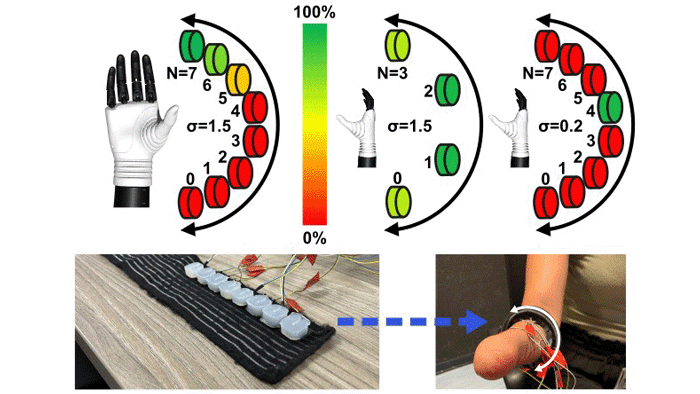Motor functions lost due to hand amputation can be restored to some extent using a myoelectric prosthesis; however, none of the commercial systems provided somatosensory feedback. The prosthesis users, therefore, do not “feel” their bionic limbs. Proprioceptive feedback is the sense of limb position, which if restored, would allow perceiving prosthesis movement without the need for constant visual attention.
We propose a novel approach to provide feedback on wrist rotation using an array of vibration motors placed around the forearm (residual limb). The motor intensities are modulated according to a moving Gaussian profile parametrized by the number of motors (N) and the “width” (σ, standard deviation). The approach generates tactile sensation that smoothly rotates around the forearm congruently with prosthesis wrist rotation, but the quality of sensation depends on the two configuration parameters. We, therefore, conducted an experimental assessment to investigate how N and σ affect the performance of closed-loop prosthesis control and user experience.
Fifteen able-bodied subjects and one individual with congenital limb deficiency used vibrational feedback to control a virtual hand in the target-achievement test. Performance was assessed by end-point error, efficiency, and subjective rating. The results showed a preference for smoother feedback (higher σ) and more motors (8 and 6 versus 4). With 8 and 6 motors, the standard deviation could be modulated through a broad range of values (0.1 – 2) without a significant performance loss (overall error: ~ 10%; efficiency: ~ 30%). For low values of standard deviation (0.1-0.5), the number of motors could be reduced to 4 without a significant performance decrease.
The study demonstrated that the developed strategy provided meaningful rotation feedback. The proposed method is therefore a flexible and effective approach to conveying proprioceptive feedback that also allows adjusting the trade-off between sensation quality and the number of vibromotors.

